Drugstore beetle
(Stegobium paniceum)

Biology:
The rusty red to brown drugstore beetle grows between 2 and 4 mm long. Its wing covers are covered with fine hairs (double coat of hair made up of flat-lying and protruding hairs; in addition to the lack of bump on the thorax, this is an important way of distinguishing it from the common furniture beetle) and feature dotted stripes. The head is covered by the pronotum for this species, which is part of the woodworm beetles family (fam. Anobiidae), and the last 3 sections of the antennae are significantly extended. The beetle is a good flyer. The white larvae live in the nutritional substrate and make cocoons there, in which they also shed their skin and pupate. The drugstore beetle is one of the most common pests in households, pharmacies and drugstores.
Damage:
The larvae cause damage when they feed, whereas the beetle itself does not feed. The larvae are omnivores and affect a wide range of plant-based and animal-based products. You find them in baked goods, pasta, grains, grain products, drugs, cocoa and many more foodstuffs, but also in leather, book covers and more. Affected goods become contaminated and the appearance of the goods is destroyed by bite marks and exit holes.
They also eat through packaging material, such as paper, cardboard and even sturdy plastic packaging (buckets, etc.).
The beetle is occasionally mistaken for the common furniture beetle (Anobium punctatum), which looks very similar but is actually a dreaded wood pest. It is therefore essential that you enlist a specialist to determine the type of creature.
